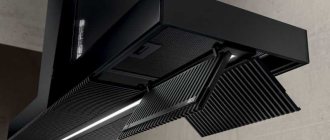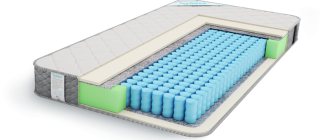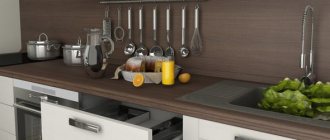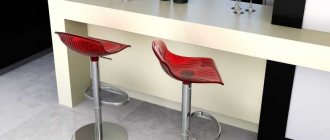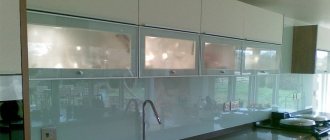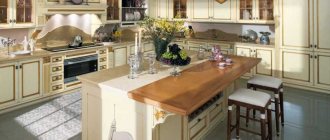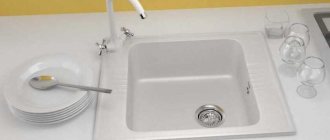Types of hoods and their photos in the interior
A properly selected hood in the kitchen interior works perfectly at the highest temperatures and protects against hot fumes, greasy condensation, excessive humidity, and overheating.
You can classify devices according to their operating principle, degree of performance and power, and amount of electricity consumed.
They also differ in their design features and price. The cost of the device depends on the availability of various additional options that help improve overall performance.
Classic hood
Classic is a good choice for anyone who loves traditional solutions and simple technical devices. You can place the unit above the stove, put it in a closet, or decorate it. This option can be straight or angular. But a corner hood for your kitchen is a specific option that is less common.
It is installed when the hob is not installed as standard.
Classics are usually wall-mounted, they do not become outdated, and the technological “filling” is improved and updated every day.
Externally, the classic evokes nostalgia - it is good to take it for an antique, retro kitchen, for a traditional interior, colonial or country, Provence.
At the same time, the corner version looks unusual and saves space. And this is also a completely classic solution, because its main principle is visibility and fit into the interior.
The suspended type of devices is convenient and easy to install.
Wall-mounted hoods are mounted on the wall and often have retractable panels - this helps to significantly expand the coverage area. They can be island-type, this is convenient if the stove is located away from the wall.
Built-in hood
Typically, kitchens with a built-in hood photo have a harmonious appearance, because the built-in appliances are hidden from prying eyes. You can mount a built-in model of an exhaust hood inside a niche in a closet or bedside table.
It is very efficient due to the sliding panel, which increases the working surface.
The main advantage of a built-in hood is that it is simply not visible.
The built-in version can be easily mounted inside furniture - in a niche or in a closet or cabinet. The retractable panel ensures portability and usefulness of the device. The filters require periodic washing and cannot be removed or replaced.
The aesthetics of the interior are perfectly preserved.
Dome hood
The dome hood resembles a fireplace in its shape. For the operation of such a device, it is important to have a ventilation system connected to the air duct.
Even at the dawn of the appearance of domes, there were no filters in their composition, and performance was ensured by drawing out air and the speed of supply of the air mass.
But these days, the quality of technology has increased significantly, and the popularity of dome hoods has also increased. Many people are not satisfied with the large size, but high efficiency was achieved through scale.
Perhaps dome systems can be called the most common. The sizes are already supplied in a variety of sizes - from large to quite compact without a large air duct.
The design of models is also progressing; today you can choose any design and type of material. Traditionally, systems are made of metal alloys and plastic. But there are glass domes, made of natural wood.
Built-in fans improve efficiency and performance. There are built-in filters.
Retractable hood
This version of ventilation is convenient in a small apartment, studio or small space. Ergonomics is ensured by the mobility of the working panel.
It is also called a slider, folding or telescopic, depending on the type of design.
Filtration at two levels ensures natural circulation of air masses, while the device operates at standard speed when air passes through the shafts without changing temperature. Sensors signal when filters are dirty and help clean the system in a timely manner.
Most often this is a flat shape, which allows you to leave free space at the top. No complex structures of pipes and bends will be required.
Island hood
This type of device, such as an island device, is distinguished by the ability to be mounted on the ceiling directly above the stove, regardless of location. A good hood for an island in a modern kitchen simply and inexpensively solves the issue of air filtration and saves space.
When the stove moves away from the wall or you need to change its location, you don’t have to link the kitchen renovation with flow ventilation.
Wall cabinet
When installing the device in a wall cabinet, you should measure it in advance. This is the best option, but you need to prepare an outlet.
It is best if it is located above the cabinets. The devices are:
- built-in;
- flat;
- dome
The built-in 60 cm hood is currently the most popular. This is what is attached to the cabinet or countertop.
It is effective if the cooking surface is no more than 60 cm. If it is larger, then not all the air, but only part of it, will be drawn into the grease filter. Flat hoods are similar to a stove; they are attached to the wall.
The dome one is quite expensive. It is installed above the stove, the bad air goes outside the kitchen, outside. There are different sizes: 50 cm, 90 cm, others.
Practical characteristics of hoods
Original wall hoods, which come in different models, are in great demand among the population, including:
- block;
- built-in;
- classic;
- domed.
It is customary to install the latter anywhere, regardless of the location of the furniture sets.
A unique built-in hood for the kitchen involves arrangement of specially prepared cabinets inside, which are assigned the role of a kind of storage for the device.
Inexperienced newcomers to the household appliances industry are interested in the burning question of how to choose a hood that will perfectly meet not only the personal needs of the direct owner, but also the needs of the room.
Advantages and disadvantages of built-in hoods
The advantages of built-in modifications include:
- Invisibility, which allows you to successfully fit this household appliance into any interior. A hood hidden behind a furniture façade will not be conspicuous and, when not working, will be practically invisible to prying eyes.
- Compact sizes. Built-in hood models take up little space, which makes them an ideal option for small kitchens.
- Low noise level as a result of low fan power.
- Low electricity consumption.
- A large number of design options and models from manufacturers.
- Easy installation inside kitchen furniture. Any householder who has experience in handling tools can install the hood.
We recommend reading: How to choose an island hood for your kitchen
There are not many disadvantages of built-in hoods, but they still exist:
- Less productivity than dome modifications.
- For recirculation models, it is necessary to replace the filters from time to time or clean them of contaminants.
- The need to select a built-in hood to fit an existing kitchen unit, or to manufacture a hanging cabinet to fit the dimensions of the hood.
The relatively weak power of the built-in hood cannot be considered a disadvantage, since such models are designed to clean small-sized kitchens, and this performance is quite enough to clean a kitchen area of 6-9 m2.
Classification of hoods
A properly selected kitchen hood with ventilation outlet should be characterized by ideal performance parameters, which are formed depending on the amount of air removed per hour.
Experienced specialists recommend choosing high-performance hoods for large rooms.
This exclusive kitchen hood without outlet operates on the principle of air recirculation.
Thanks to the motor device, a fan is driven to properly move air through a pair of filtration stages.
The first is represented by a grease trap, which ensures effective retention of particles of dust, soot and heavy types of fumes.
The second is presented in the form of a carbon filter, which neutralizes foreign odors and the smallest particles of passing air.
Full operation of such a hood is ensured by connecting to the electrical network.
Additional features
A high-quality range hood of any type has several engine operating modes. The mode can be changed depending on the degree of smoke in the kitchen.
The hood should not turn off immediately after pressing the corresponding button. It must work for a few more seconds to expel the dirty air from the pipe. Otherwise, he will enter the kitchen again.
Some hoods have a turbo mode. Enhanced ventilation can be turned on in an emergency, for example, when something is badly burned on the stove and there is smoke in the kitchen.
Illuminated hob. Now almost every model has hoods.
Tips for using hoods
Sometimes it happens that homeowners purchased a hood, installed it, and then staying in the kitchen began to bring severe discomfort.
A similar problem is associated with hoods, the operation of which is accompanied by huge noise waves, making it impossible to continue a conversation in the room without raising the voice.
Therefore, the noise level of the device becomes one of the determining factors in a successful choice.
Excellent silent kitchen hoods operate discreetly without causing additional problems for apartment residents and guests. A person who is faced with the need to select elements of household equipment for the first time does not know which hoods are best for the kitchen.
Criteria for selecting kitchen hoods
With most online stores specializing in the distribution of equipment, there is an additional option for delivery, installation and commissioning, which is convenient for customers.
In the process of final selection of a hood, you should be guided by the main structural, operational, and technological characteristics, which are formative for the functionality.
It is important to take into account the design of the device so that it succinctly fits into the overall stylistic concept of the room’s decoration.
Effective installation of a kitchen hood is a fair solution for those housewives who want to experiment with preparing culinary masterpieces and maximally preserve the integrity and presentability of the property.
Why is it so important to have a hood in the kitchen?
A range hood is a necessary element in a modern kitchen. It performs an important function - it purifies the air in the kitchen. And plus, it should fit into the design and complement the interior of the kitchen.
What are the benefits of a hood in the kitchen?
Cleaning the air from unwanted fumes.
A kitchen is a place where food is constantly or regularly prepared. Any cooking process is accompanied by frying and cooking, or more precisely, it is steam, smoke, many different aromas from food and splashes of fat during frying.
All this spoils the kitchen and permeates the apartment, furniture and clothes with the aromas of cooked food.
For the kitchen owner, the process of cooking becomes not the most pleasant, since it is too hot in the kitchen from all the fumes and one window will definitely not save you. A range hood helps control aromas, fumes and smoke in the kitchen, making the cooking process more enjoyable.
Additional lighting.
There should be enough lighting in the kitchen; this is usually the main light and light in the work area (spotlights are used). If there is a hood, then there is no need to install lamps above the stove, since the lamp that is in the hood is enough to illuminate the area.
Plus, lighting without an exhaust hood will quickly become dirty, which makes cleaning the kitchen more difficult.
Saving money.
Since food is constantly being prepared in the kitchen, the work area must be washed frequently. Cleaning the kitchen after every meal preparation is not always possible.
And grease, fumes and plaque remain on the countertop, on the wall and even on the ceiling.
To clean the kitchen, you need to buy aggressive detergents or any other, make repairs (at least cosmetic). This requires spending money and a lot of time.
A good hood will help with this problem, but you need to use it every time you cook.
Makes cleaning around the hob easier.
The hood will not completely eliminate the need to clean the work area, but turning it on every time during cooking will result in less plaque and less grease deposited on the countertop and, first of all, on the stove. This will reduce cleaning time and make it easier.
What are the most popular built-in hoods?
An under-cabinet hood that is often chosen is installed in a cabinet above the stove. Thanks to the pull-in and pull-out function, it takes up even less space and does not dominate the kitchen design. Despite the fact that there is no arguing about tastes, in recent seasons the black hood , which can be combined with almost any color and character of the furniture. Silver is also a popular color that has dominated modern kitchens for many seasons.
Parameters by which the hood may differ
Hoods vary in shape
Dome hood
Quite large in size, attached to the wall or possibly to the ceiling. For this, it is necessary to have a ventilation system in the kitchen. Such a hood will be quite powerful and productive, and depending on the price, you can choose a model that is not too noisy.
This hood has a grease filter (grease and other things settle on a metal mesh), the filter must be cleaned periodically.
Flat hood
This hood is smaller in size than a dome hood, more compact and convenient. It is attached to the wall above the stove; the installation process is simpler than with a dome hood. And at the same time, it also has less power and performance.
Quite noisy during operation, but this depends on the price and model.
Unlike a dome hood, a flat hood does not require a ventilation system, since the air is not exhausted, but filtered. The air is filtered using a grease filter and a carbon filter.
The grease filter must be cleaned periodically, and the carbon filter must be changed every six months (possibly more often, depending on use).
It is best to choose a dome hood, but if the kitchen is small, then you can get by with a flat hood (you can place a wall cabinet above the flat hood).
Hanging
Hanging hoods are also called classic; they are quite simple, which is why they are popular. The hood is installed above the stove or under a wall cabinet.
The air that the hood sucks in is most often filtered (recirculation mode) and less often discharged into the ventilation system (depending on the hood model).
Most often, such a hood contains a carbon filter (it needs to be changed) and a grease filter. It runs on one motor, so performance is lower.
The hanging hood is quite simple in its operation. Its productivity is low and there is no way to increase its work area.
Built-in
This hood is built into a wall cabinet, which is convenient, compact and practical, especially in a small kitchen. The air (depending on the model) can be filtered and discharged into the ventilation system.
Typically, such a hood has two motors, which guarantees good performance.
A grease filter in which you need to periodically wash the metal mesh. The retractable panel increases the working area of the hood. Switching on is done by “pulling out” the panel, and switching off by “pushing in” the same panel.
The built-in hood is convenient, takes up little space, works well (high performance) and is therefore not cheap.
The better and higher quality the material from which the hood is made, the longer it will last.
Material
Tempered glass
This is the most expensive material. A hood made of tempered glass looks very beautiful, prestigious and expensive, but, unfortunately, this design is fragile.
This material can be molded into any shape for drawing and decorated with ornaments.
Aluminum
This material is also quite expensive, but cheaper than tempered glass. It looks beautiful, elegant and expensive. An aluminum hood will be quite durable. It can be washed with any detergent.
Maintenance is simple and the hood is easy to clean. Thanks to the special coating, fingerprints do not remain.
Stainless steel
The material is not the most expensive and quite durable. The stainless steel hood looks good. The material is easy to care for. Do not wash it with abrasive powders or use a metal sponge.
Enameled metal
The cheapest material. Quite strong and reliable. Easy to care for. Can be washed with any detergent. The appearance is very simple and not particularly beautiful.
Hoods vary in power
An important point in the operation of a hood is its performance (this is the amount of air that it can clean in one hour of operation).
The hood power depends on the type and design of the built-in motor. It also depends on whether there is one built-in motor or two. Two motors in a hood are rare, they are more expensive and the size of such a hood is larger and noisy.
In order to determine how powerful the hood should be, you need to multiply the area of the entire kitchen by the height of the kitchen. After which you need to multiply the amount by the air exchange rate (according to SES - 12).
For a kitchen with 9 square meters and a ceiling height of 2.7, the hood performance should be approximately 250 to 325 cubic meters per hour (this depends on how intensively the stove works).
By control devices
Push-button
The simplest and most inexpensive option. Usually equipped with buttons and various sliders (to change the power and turn on/off the light), which are located on the front of the visor.
Push-button control is convenient, familiar and simple for all people, but more difficult to maintain.
Touch
A hood with touch control is more expensive and looks much better in a modern kitchen. The controls are not so simple and familiar, but quite convenient.
It turns on and off with a light touch, without any effort at all.
It is much easier to care for such a hood. In addition, modern and expensive models have automatic control, such as automatic speed switching, a timer, an indicator of hood contamination, as well as an on/off sensor (when the stove turns on).
With or without venting
All hoods are divided according to two main principles:
- Removing air or venting;
- Air filtration is also called recirculation mode.
In the first case, the air that the hood sucks in is discharged through the building ventilation. Of course, this option is the best and most effective. This hood rids the room of dirty air and unnecessary fumes. Works efficiently and powerfully.
Suitable for large and small kitchens, in terms of power, but in terms of dimensions in a small kitchen it will take up a lot of space.
The disadvantages are complicated installation and noise during operation.
In the second case, the hood sucks in air, which is cleaned using built-in filters and then flows back into the kitchen. This is an ideal solution if it is not possible to use an air duct, and is also a good option for a small kitchen.
Installation is very simple, takes up little space and the filters are easy to maintain. Quiet operation of the hood. However, it is not the highest price.
The downside is that it is not the most productive operating speed.
By filter element
Two types of filters are used in kitchen hoods:
- Grease filters are disposable and reusable;
- Carbon filters or fine filter.
Grease filters trap particles of fat and soot, protecting the internal parts of the hood.
Disposable filters are made of synthetic fiber (can be paper or padding polyester). They need to be changed when they become dirty. Their convenience is that they do not require maintenance, only replacement.
The reusable filter is made of aluminum and stainless steel. It looks like a metal mesh. It must be washed when it gets dirty. This filter lasts quite a long time.
The carbon filter is located after the grease filter. It is necessary to absorb unnecessary aromas and vapors. The filter absorbs all harmful substances and cleans the air well. The carbon filter must be changed on time.
Built-in kitchen hood – practical and functional
A built-in hood is a good solution for almost any kitchen, as it performs its function and does not affect the interior design - it is installed at the bottom of the cabinet, which makes it invisible. Thanks to this, you can arrange kitchen cabinets and other appliances as you wish.
Under-cabinet hoods are most popular in small kitchens where all space-saving techniques are of great importance. We appreciate this type of hood even when there is no possibility of connecting to ventilation.
If you are installing a hood in a closet, remember that it should be slightly narrower than the furniture - in order to “cut” it in, you need to make a hole, without a few extra centimeters this can be difficult. It is also good if the surface of the built-in hood is slightly larger than that of the stove - about 10-15 cm. This increases the efficiency of the device.
How to install a hood with a ventilation outlet
You can install the hood yourself; this is not an easy, but completely doable task.
Required tools and materials:
- Corrugation or plastic box;
- Ventilation grille;
- Fastening or clamps (clamps, 2 pcs.) for corrugation;
- Drill;
- Screwdriver;
- Tape measure, pencil and level;
- Hacksaw for metal (for corrugation), knife.
Before you start work, you need to take measurements of where and at what height the hood will be located. It is necessary to correctly determine the distance from the stove to the hood and attach it securely.
Next you need to hang the hood to the wall and secure it securely. To do this, a frame of dowels and angles (U-shaped) is attached to the wall, this will be the support.
There is an option in which the hood is attached to kitchen cabinets.
Next, the corrugated pipe is attached using clamps to the ventilation system and to the hood itself. After which the hood is connected to the network.
Kitchen hood – what is it for?
Someone can be sure for a long time that this item is completely unnecessary. However, you need to understand the benefits of such devices in kitchens:
During the cooking process, as a rule, combustion products and various fumes are released that are very harmful to the human body.
This situation is relevant in the case of a gas stove that emits carbon dioxide. Well, an electric stove also emits a lot of contaminants, especially grease and soot. But they definitely need to be removed, not to mention filtered, which kitchen hoods do very well.
There is also an aesthetic nuance. This applies to smells.
After all, not all products have wonderful aromas during their preparation. For example, there is a rather specific smell of fish, which, on top of everything else, “loves to eat into” everything it can. And even more so, the issue of odors is relevant for pregnant women.
In fact, there is a lot to be said about the toxic period. One of its frequent and widespread manifestations is intolerance to certain odors. And it’s very difficult to get rid of them all at once in kitchens. This is why a built-in kitchen hood is a must!
Fumes, fats, soot - all this is typical for kitchens, settling on everything possible: walls, ceiling, floor, furniture and so on. You can wash some interior items, equipment or dishes, even with a lot of effort, but with walls and ceilings - everything is much more serious.
After a few years, they will completely lose their original appearance, and you will simply have to renovate the kitchen space again.
Why is there such a big difference in prices for cabinet hoods?
The cheapest model costs 4,800 rubles, the most expensive – more than 64,000 rubles. The difference, of course, is in the details. Expensive hoods have aluminum grease filters and stainless steel and glass trim, making them very elegant. More expensive hoods have touch controls, and some models have a built-in filter contamination indicator and an electronic indicator that displays the device parameters. However, one of the biggest advantages is the high-quality grease filter, which prevents greasy deposits from settling on the furniture.
Filters for hoods - how to choose?
It doesn’t matter at all which model you prefer: a kitchen hood with or without an outlet, but filters must be present in each of them!
You already roughly understand how to choose a kitchen hood, but it is also important to know about the filtration system, which is a fundamental factor in the operation of any unit.
Filter - oil trap
They do an excellent job of filtering oils and fats released during the cooking process. After all, they are very light in a molten (melted) form, but when they cool down, they turn into black, greasy and sticky mud, which simply has a disgusting smell.
And such pollution will not only spoil the appearance of the walls, ceiling and other objects in the interior.
Moreover, it has a very negative effect on the operation of the motor in the unit. It is for this reason that the hood can break down literally within a few months from the date of purchase.
And in order to prevent such a nuisance, you should immediately buy and install a filter in it - an oil trap, which can be:
- Disposable. They are made from acrylic, non-woven or synthetic padding. Their appearance resembles a soft rug. When dirty, such a filter must be replaced.
- Reusable. Such a filter will only have to be replaced if it suffers mechanical damage. Its purpose is forever, “together with the hood.” In other words, there is no need to change it. It looks like a metal grill with many layers of foil and fine mesh.
This filter must be washed from time to time, depending on how dirty it is.
The disposable filter cannot be washed! After washing, it will not only lose its appearance, but it can also cause damage to your hood!
Carbon filter
The basis of such components is activated carbon. Thanks to its absorption properties, the air in the kitchen is perfectly cleaned!
Of course, they can handle fats and oils. But still, their main task is to neutralize various odors in the kitchen that appear during the cooking process (and especially frying or boiling). Thanks to the presence of a carbon filter, the hood reduces its productive power by approximately 1/5.
Accordingly, the longer such a filter is installed, the worse the air will circulate.
For this reason, the “validity” of such a filter is approximately 3–4 months. However, each manufacturer of such accessories makes its own recommendations regarding the period of operation.
Immediately after you have finished the cooking process, do not turn off the hood if you have a carbon filter installed. Let her work for a few more minutes. This will allow all the excess moisture to escape from the filter, making it last longer!
